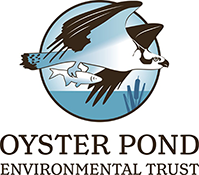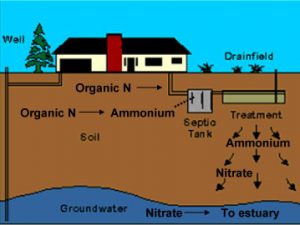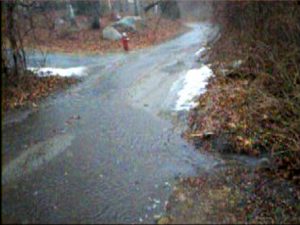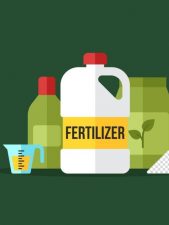Science
Managing Nitrogen Pollution in Oyster Pond
Too much nitrogen and to a lesser degree, phosphorus, have altered Oyster Pond. Wastewater from septic systems is the primary source of nitrogen (71%) with stormwater runoff and garden fertilizers making up the remainder (26%).
These are the findings of the Massachusetts Estuary Project (MEP) Report for Oyster Pond released by a technical team comprised of the University of Massachusetts Dartmouth School of Marine Science and Technology, the Massachusetts Department of Environmental Protection (DEP) and the Cape Cod Commission.
Just as nitrogen feeds your garden plants, it also feeds the plants or algae in the pond. This growth in vegetation in turn decreases the amount of oxygen available to fish and other aquatic dwellers. It also increases the turbidity or cloudiness of the pond. In the mid-1980’s, an abundance of aquatic vegetation made it difficult to swim or boat in the pond. It was even worse in the hot, dry summer of 2016 when the pond turned pea soup green with a toxic algal bloom.
The impacts of these excessive nutrients are most dramatic at the basic level of the pond and far from our sight. It is causing a shift in the pond’s benthic animal communities. One measure of a water body’s health is to look at the diversity, distribution, and population of these pond bottom dwellers. The Oyster Pond MEP found few species, only an average of 3 species per sample, compared to 30 species per sample in a nearby healthy estuary. The numbers of these animals were low and unevenly distributed, all indicators of a stressed, impoverished community and habitat suffering from excessive nutrients.
In 2014 the Oyster Pond Watershed had:
- 211 parcels = 727 acres
- 166 parcels = 271 acres
- 225 dwelling units
- 603 bedrooms
- 48% seasonal use
- 24% land in conservation*
- 8% remaining developable vacant land *
- Wastewater 28,900-gpd annual average
- 160 dwelling units added since 1977
*estimated prior to Headwaters purchase
Too Many Septic Systems
The problem of too much nitrogen entering the estuaries throughout Falmouth was first recognized in the mid-1980s. The main culprit was identified as backyard septic systems. While Title V septic systems are excellent at removing pathogens from entering our waterways, they remove only some of the nitrogen. Nitrogen from our wastes, soaps, laundry detergent, and food scraps enters our septic systems and leaches down through the soils into the groundwater. The groundwater gradually migrates downhill entering Oyster Pond and other estuaries.
When Falmouth’s population was low, salt ponds and estuaries could absorb this extra nitrogen. The residents of Falmouth have historically been reluctant to install sewers in the Town due to the very high costs and the worry that it will spur too much growth, ruining the character of the the Town. However, some growth has happened anyway. As the population has grown, so too has the number of septic systems leaching nitrogen, increasing the amount and concentration of it in our estuaries. It is now too high for water bodies to absorb and is known as eutrophication. The same population growth has occurred around Oyster Pond.
Since the 1980s, concerned residents of Oyster Pond have been working on trying to mitigate the impacts of this excess nitrogen. The Pond Watchers were part of this effort to document the condition and amount of nutrients in the Pond. In 1985, OPET began its own Water Quality Monitoring Program.
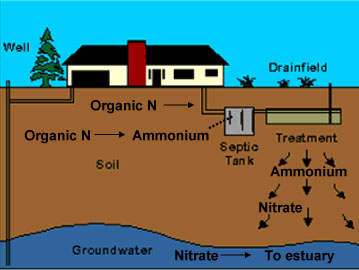
How nitrogen moves from homes to estuaries Organic nitrogen is collected in a septic tank, where organic N decomposes to ammonium. Ammonium moves to leaching fields where it is converted to nitrate. This nitrate then moves easily to groundwater and then carried to estuaries.
Solutions
How do we return Oyster Pond to a healthy ecosystem? By stopping nitrogen from entering Oyster Pond. Either the wastewater must be removed from the watershed by a sewer system or septic systems must be upgraded to remove more nitrogen from their leachate before it is released to the groundwater. If sewers are selected by the Town, 70% or 189 dwelling units in the Oyster Pond watershed will be required to tie into a sewer line. Under the Advanced I/A plan, nearly all of the watershed’s 226 dwellings will be required to upgrade their septics. This is because a sewer system removes all of the nitrogen from the watershed, while Advanced I/As will still release some nitrogen to the pond. To reach the same nitrogen removal goal, more homes will need to be included in an Advanced I/A plan.
Additionally, stormwater must be prevented from entering the pond and property owners must observe the Town of Falmouth Fertilizer bylaw.
This radio story called Fixing Nitrogen is a nice overview of the history of nitrogen pollution in Falmouth. It was produced by Amelia Ahring and Nicole Pollack, students of the Fall 2019 SEA Semester program as part of their Environmental Communication class. Very well done!
Wastewater
There are many ways to treat wastewater – BUT what will be the most economical and efficient method for Oyster Pond? That is the focus of the Town of Falmouth plan for treating wastewater in the Comprehensive Wastewater and Nutrient Management Plan (CWMP) for Oyster Pond. The Town is considering Advanced I/As or sewers to reach the required Total Maximum Daily Load (TMDL) limit.
Title V Septic Systems
TN>40mg/l
Title V septic systems are so called because they are regulated by Title 5 of the State Environmental Code. They do an excellent job of removing pathogens from entering groundwater, but not nitrogen. They only remove only about 25% percent of the nitrogen effluent from a household’s flow which is on average about 40 mg/l. Note that more frequent pumping of the septic tank will lower the amount of nitrogen coming from your septic.
Septic systems are comprised of three main components – the septic tank, distribution box and leaching field. They are designed to use natural processes to break down the wastes and remove pathogens. Most of the nitrogen in human waste is comprised of the organic form of nitrogen and urea. Microbes in the septic tank convert this nitrogen into ammonium (NH4). When the wastes move into the leaching field oxygen is made available to intercept and treat any remaining pathogens. Microorganisms in this oxygen environment convert the ammonium to nitrate (NO3). This has consequences for the fate of nitrogen in our environment: while ammonium sticks to soils and tends to stay put, nitrate moves easily through soils to enter the groundwater and then down to a receiving water body.
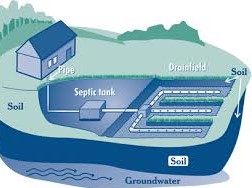
A standard septic design.
Estimated Costs:
- $8,000 – $15,000 depending on location
- Operation and Maintenance – approximately $100 a year (pumped every 2 – 4 years)
Innovative and Alternative Systems (I/A)s
TN<19 mg/l
When it was realized in the 1990s that nitrogen from backyard septic systems was a major pollution source to water bodies, it spurred the development of many Innovative and Alternative Systems (I/As). There are many different I/A technologies approved for use in Massachusetts.
I/As can differ greatly in their design, but all have at least one additional step in the treatment process. The waste is moved through an anoxic environment where yet more microbes convert nitrate into harmless nitrogen gas. I/A systems vary in how they introduce this denitrifying step. Since 1998, the Massachusetts Alternative Septic System Test Center (MASSTC) located in Sandwich, Massachusetts, has evaluated the performance and cost effectiveness of over a dozen different systems. Additional information can be found at the Barnstable County Septic Management Program.
Research at this testing center and results from monitoring tests from systems in use show mixed results in their performance. To receive DEP approval, systems “shall achieve a total nitrogen concentration at discharge not to exceed 19 mg/l.” DEP assumes that an approved I/A will reduce the total nitrogen concentration by 50% under the assumptions of Title V flows (110 gal/day per bedroom). However, testing of alternative septic systems in use throughout Barnstable County found that they don’t always perform as well in operation. Studies show they remove 50% of the nitrogen only 70% of the time.
There are possibly several reasons for this. It could be the incoming nitrogen loads entering the systems vary greatly in N concentration. If a household is parsimonious in their water use, their concentrations will be higher. The state assumes incoming influent at 50mg/l, yet some households’ Total Nitrogen (TN) can be as high as 70 – 80 mg/l. Their systems may be working great, but not meet the 19mg/l target, since I/As are designed to remove a percentage of the influent.
There is also a problem with the seasonality of the load. Many systems need six weeks to activate the microbes; if a system is only used during the summer months, it may not have enough “ramp up” time.
Additionally, an I/A requires much more maintenance to operate than a conventional septic system; if the operator is not intermittently testing and adjusting the system, it may not perform as well.
Annual operating and maintenance costs are much higher for I/As than Title Vs. There are electrical costs for running the pumps, aerators, fans and other mechanical parts. Plus Mass DEP requires that owners of an I/A system have a maintenance contract with a licensed individual or company.
Advanced Innovative & Alternative Systems (Advanced I/As)
TN< 10mg/l
The I/As under consideration for removing excess nitrogen from the Oyster Pond watershed are Advanced I/As. These systems remove even more nitrogen to reach a concentration below 10 mg/l. This is because the I/As that remove down to 19 mg/l do not remove enough nitrogen to meet the levels required for the TMDL mandated thresholds. There are fewer systems that can meet this limit.
A pilot project of some of these Advanced I/As was conducted around West Falmouth Harbor. Twenty homeowners signed up to participate in the program and received a $10,000 subsidy to offset the costs of upgrading their septic systems. The demonstration project focused on retrofitting existing Title V systems to nitrogen reducing technologies. The systems reduced the amount of nitrogen entering the harbor by 78%. The average cost to add nitrogen reduction to a conventional Title 5 system was $20,417, while full upgrades from old cesspools cost an average of $33,225.
Advanced I/As can be grouped into two main groups – patented, proprietary treatment systems and non-proprietary systems. The three most promising non-proprietary designs are the Simple “Layer Cake”, the Lined “Layer Cake” and the “Box” System. The Layer Cake design in particular has grabbed a lot of attention. It is based on a very simple design where layers of media are stacked on top of each other and as the leachate percolates down, the nitrogen is removed. The key is using woodchips to create an anoxic zone and a source of carbon that create the conditions for denitrification. George Heufelder of the Massachusetts Alternative Septic System Test Center gave a presentation to the OPET Board in Jan 2020 about I/As and their potential for use in the Oyster Pond watershed. The conclusion? They are worth continued study and show promise. Below are his conclusions.
Some of the Advantages –
- Can be designed by any qualified septic system designer
- Can use generic parts
- Operate on many of the same principles as proprietary designs
- Have a limited but successful track record
Potential Road Blocks
- Are not yet through a DEP approval process
- Often harder to find qualified designers
- May be harder to find qualified operators
- May require more frequent monitoring for approval
Management Issues:
If individual denitrifying systems are used to meet TMDLs, there must be some mechanism to provide a level of confidence to the DEP that the systems are working as required. How shall that happen? Does the Town take on the role of operator for all of these individual systems, because as noted above, it is crucial these systems are monitored and tested to insure they are meeting the effluent limits? If the Town does take on this role, what is the legal mechanism giving Town employees access to private property? Perhaps the systems will be owned by the Town? How many additional Town employees need to be hired to perform these duties? These are just some of the questions and management issues that need to considered if the Town relies on I/As to meet TMDL limits.
Sewers
If the Massachusetts DEP does not accept the Town plan to use Advanced I/As to remove the nitrogen in Oyster Pond, then a low-pressure sewer system will be installed. This is called the Traditional Backup Plan in the Oyster Pond CWMP. It would include 15,400 feet of low-pressure collection sewers around the pond; the effluent would then be conveyed approximately 6,000 feet by low-pressure transmission sewers to the Shiverick’s Pond Lift Station behind Main St. It would be then be transported via the Town’s existing sewer system to be treated and released at the Town’s Blacksmith Shop Road Wastewater Treatment Facility. Initially a total of 189 dwelling units would be required to tie into the sewer system to meet the required TMDL limits. If that does not happen, then three more units for a total of 192 dwelling units would be served by sewer.
A conventional gravity sewer system is not feasible around Oyster Pond due to the steep terrain and nearness to the waterfront. With the low-pressure system, each dwelling or possibly a cluster of buildings will need a pumping system known as a grinder pump. The grinder pump acts like a garbage disposal by grinding a household’s water waste from toilets, washing machines and showers, etc. and pumping it to the sewer collection pipes.
This collection system can represent some of the highest costs of a sewer system, from 50% to 75% of the total capital cost of a system. This is due to the long length of piping needed to connect to each dwelling.
Management Issues:
Ownership and maintenance of the grinder pumps can be an issue in this type of system. Who owns, operates and maintains the grinder pumps? They will be located on private property, so an easement is needed to allowed the Town access to the pumps if needed.
As a precedent, in the Little Pond sewer area, the Town purchased grinder pumps with a 5-year warranty and provided them to homeowners. It was the responsibility of the homeowner to pay for installation of the grinder pump. However, the Town did give homeowners a $1800 rebate for the installation costs. The Town will maintain the grinders once the 5-year warranty expires and will replace them at the end of their service, which is typically 15 to 20 years (if there is no evidence of misuse).
When the grinder pumps were picked up for installation, the property owners had to sign an agreement transferring ownership of the pump from the Town to the property owner. This agreement also gave the Town or its agent permission to enter onto the property to service the pump.
Homeowners should be aware that having your home hooked up to a sewer system with a grinder pump does not mean that you can forget about it as is the case with a traditional sewer system. For one thing, the pumps will not work during a power outage. Once the storage capacity of the pump is full (from 38-46 gallons), sewerage can begin to back up into the building. The pump system also must be winterized if the house is empty over the winter. Homeowners also must realize that the grinders cannot accept certain objects such as diapers, sanitary items or hazardous materials. (Normal septics can’t either!)
Stormwater
Although wastewater effluent is the major contributor to the excess nitrogen polluting Oyster Pond, stormwater is also a contributor. Stormwater runoff is rainwater and melted snow that runs off streets, lawns, driveways, roofs or any other surfaces. As the excess water flows over impervious surfaces, it transports soil, pet waste, oil, fertilizer, trash, cigarette butts or anything else that could get swept up by the stormwater runoff. The contaminated stormwater runoff can pollute Oyster Pond with excess nitrogen, phosphorous and other nutrients along with harmful bacteria and toxins.
The adjacent video shows Ransom Road stormwater runoff prior to the installation of catch basins in 2009. There are three other stormwater inputs identified in the CWMP for Oyster Pond:
- a pipe from Oyster Pond Rd that empties into a wetland adjacent to Oyster Pond
- a drywell overflow pipe from Landfall at Treetops that flows down the hill to the pond
- a pipe on Quonset Road to Oyster Pond
There are several do-it-yourself stormwater management options that can minimize stormwater runoff from your property to stop harmful pollutants from entering Oyster Pond and other water bodies. Questions to consider include: Does water run off my driveway into the street or does it pool up at a certain location on my property? Where do my downspouts drain and are they causing any unnecessary erosion? Are there things I can do to prevent stormwater pollution from entering Oyster Pond? All homeowners can assess their property and take steps towards protecting Oyster Pond.
This 2007 video of road runoff running down Ransom Road and directly into Oyster Pond demonstrates how stormwater can pollute water bodies. The stormwater didn’t look like much at the top of Ransom Road, but it as it moved down the road and picked up runoff from homes and driveways it grew larger and larger carrying with it pollutants and grit. Even small amounts of runoff from properties can accumulate together to cause environmental problems. Catch basins were installed in 2009 and now capture and filter stormwater before it enters the pond. This is particularly important for the “first flush” of precipitation as the initial runoff carries a higher concentration of pollutants.
Direct Downspouts away from Pavement
One of the easiest things you can do is direct downspouts from the house away from pavement. Many homeowners have their downspouts drain directly onto their driveway. This increases the amount of water that leaves the homeowner’s property and directs any harmful pollutants from rooftops toward storm drains and potentially into Oyster Pond. Directing downspouts toward permeable soil allows water to infiltrate into the ground and minimize stormwater runoff. Direct the downspout toward a mulched area, rain garden, dry well or any other permeable surface. This also prevents slippery driveways and walkways when temperatures drop.
Install Dry Wells
Dry wells collect runoff from roof downspouts or other locations where concentrated amounts of water flow off of rooftops.
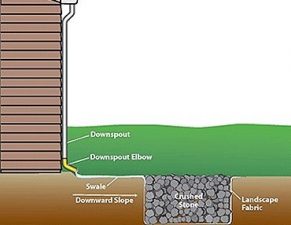
Simple dry well intended to catch runoff from roof Credit: Philadelphia Water Department
They allow water to enter the groundwater, rather than run down the driveway, and prevent erosion. Essentially, a dry well is a hole in the ground that is lined with landscaping fabric and filled with crushed stone. A homeowner can choose to bury the downspout or simply point the downspout in the direction of the dry well. If the downspout is buried, it allows the homeowner to cover the dry well with mulch or grass to make it less noticeable. A typical dry well intended for runoff from a rooftop is 3 feet deep and 3 feet wide. It is important to install the well away and downhill from the house to ensure the water drains away from the house.
Pick up after your Dog
Human waste from septic systems is the primary source of nitrogen in Oyster Pond, but it is also important to properly dispose of pet waste.

Pet waste contains high levels of nitrogen, just like human waste. According to the Massachusetts Nonpoint Source Pollution Management Manual, runoff containing pet waste can also contribute to the spread of:
- Campylobacteriosis – a bacterial infection that causes diarrhea in humans.
- Salmonellosis – the most common bacterial infection transmitted to humans from animals. Symptoms include fever, muscle aches, headache, vomiting, and diarrhea.
- Toxocariasis – roundworms transmitted from animals to humans. Symptoms include vision loss, rash, fever, or cough.
If pet waste is not properly disposed of, stormwater can carry these toxic organisms into Oyster Pond. Make sure to carry a dog waste bag with you when walking your dog and properly dispose of it afterwards.
Create a Rain Garden
Rain gardens are shallow depressions designed to accept stormwater. Water is directed into the area, allowing runoff to filter and percolate through the soil and then infiltrate the ground.
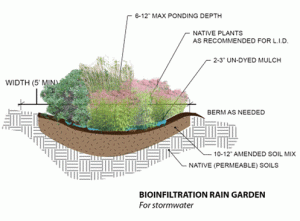
Cross-Section of a rain garden. Photo: Cape Cod Commission
They are filled with sandy soil and topped with a thick layer of mulch and native, deep-rooted vegetation. According to the Massachusetts Watershed Coalition, a properly designed rain garden can reduce runoff from impervious surfaces by up to 98% and remove 80% of the suspended solids that clog streams and storm drains.
If you wish to create a rain garden here are some things to take into consideration. First watch how water collects and moves across your property and locate the garden within that area if you can. Also place it away from your septic system and 6ft to10ft away from your house to avoid damp basements. For a rain garden to work properly, it is important to have permeable soil. Luckily, like most of Cape Cod, much of the Oyster Pond area has sandy soil. It is also crucial to pick the right mixture of plants that can handle both wet and dry conditions. Locate plants that can withstand a few days of flooding in the middle of the rain garden where standing water will last the longest and drought resistant plants around the perimeter. A healthy mix of native shrubs and perennials that are adapted to local growing conditions are ideal.
Rain gardens, like any garden, need to be maintained on a regular basis to ensure long-lasting effectiveness. This includes mulching yearly, removing diseased plants and removing excess sediment and litter. Rain gardens can enhance and beautify a property. Much more information on constructing rain gardens for your home can be found at the Association to Preserve Cape Cod. It includes more detailed instructions and a list of suitable Cape Cod native plants.
Install Rain barrels
An effective way to reduce stormwater runoff and conserve water is to install a rain barrel. Rain barrels capture water from gutters and store it for future use.

A residential rain barrel with hose connected Photo: EPA.gov
According to the Environmental Protection Agency, lawn and garden use accounts for 40% of household water use during the summer months, but rain barrels can help offset that water usage. This can be especially helpful during the droughts that impact Cape Cod some summers. The average homeowner can save 1,300 gallons of water. Ready-made rain barrels can be purchased from most hardware and garden supply stores as well, Association to Preserve Cape Cod or you can make your own with any large barrel or drum. To install a rain barrel:
- Place rain barrel on level ground near a down spout.
- Measure the downspout against the rain barrel and mark where it should be cut. Strap the downspout to the building above this mark.
- Cut the downspout at your mark and crimp edges before sliding into rain barrel.
- Attach the hose to the bottom spigot after inserting the downspout into the rain barrel.
Careful Washing your Car
Washing your car on a driveway or street can cause harmful nutrients, metals and hydrocarbons to run off into the streets, down storm drains and potentially into Oyster Pond.
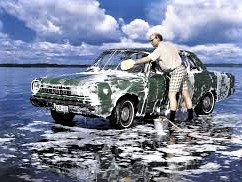
Remember – You’re not just washing your car in the driveway, but also downstream waterbodies. Photo: Washington State Dept of Ecology
Some steps you can take to reduce your impact while washing your car include:
-
- Using a commercial car wash – Car wash facilities in Falmouth are required to treat and recycle their water.
- Wash your car on lawn or other permeable surface – Many driveways are sloped so water drains directly into the street. If this is the case with your driveway, wash your car on your lawn. This allows water to infiltrate into the ground rather than going into the streets and down storm drains.
- Divert water towards grass or landscaping that provides infiltration – If washing your car on your driveway is your only option, attempt to block runoff from going into any storm drains. Use a device to divert the water towards a location that allows the water to naturally be absorbed into the ground.
- Use biodegradable soaps – There are many biodegradable soaps on the market.
Fertilizer Use
Great Looking Lawns and a Healthy Oyster Pond
Using fertilizer wisely on your lawn is another way home owners can help Oyster Pond and other waterbodies. The Massachusetts Estuaries Project calculates about 10% of the nitrogen harming our estuaries comes from fertilizer! This is why the Town of Falmouth enacted a Nitrogen Control Bylaw to guide homeowners as to the best practices for growing a healthy lawn while protecting our waterbodies.
Traditional Cape lawns have endured for generations without fertilizer, and with very little water. Recycled grass clippings and atmospheric deposition (mostly rain) are natural sources of nitrogen! In many cases, this is all established lawns need. Even high-end turf, if treated properly, requires very little added nitrogen to flourish on Cape Cod.
The Town Bylaw applies to the use of fertilizer for lawns only. It does not apply to fertilizer used on flower or vegetable gardens, greenhouses, houseplants, farms, or orchards. The Bylaw also does not apply to the establishment or repair of turf (after substantial damage) in its first growing season. More information about the Bylaw – What you need to know about Falmouth’s Nitrogen Control Bylaw for Fertilizer.
Key provisions of the Bylaw:
- Don’t fertilize your lawn between October 16th and April 14th or before or during a heavy rain event.
- Don’t fertilize any lawn located within 100’ of wetlands or waterbodies.
- Avoid spreading fertilizer on paved surfaces; sweep it up if you do.
- For lawns outside of the 100’ prohibited zone, use organic fertilizer sparingly.
You can have a lush green lawn without using nitrogen fertilizer and pesticides.
Here’s how:
- Leave grass clippings on lawn – the best and easiest source of nitrogen for your lawn!
- Top dress with organic compost to build up to an ideal 6” of topsoil; if you don’t have it, add 1/4″ to 1/2″ of loam or compost top dressing every year.
- Seed with a mix of native grasses, fescues and perennial rye grasses. No Kentucky Bluegrass for the Cape.
- Learn to use de-thatching, aeration, and overseeding to encourage thick, healthy turf that defeats weeds and pests.
- Keep grass at least 3” tall – high grass shades out weeds.
- Mow with sharp blades – prevents the introduction of diseases into torn turf.
- Only water deeply once a week (1″ each week) – this encourages longer grass roots and more drought tolerant turf.
- Soil should have a pH level of 6.5-7.0. Modify as appropriate to reach this level. Grass clippings and atmospheric nitrogen are enough to keep a lawn healthy for years, but if you must fertilize, do so only OUTSIDE the 100’ restricted areas in the spring and/or fall with water-insoluble nitrogen and limit your applications to a yearly maximum of 1 pound of nitrogen per 1000 square feet. Contact your local landscape contractor or garden supply house for information.

